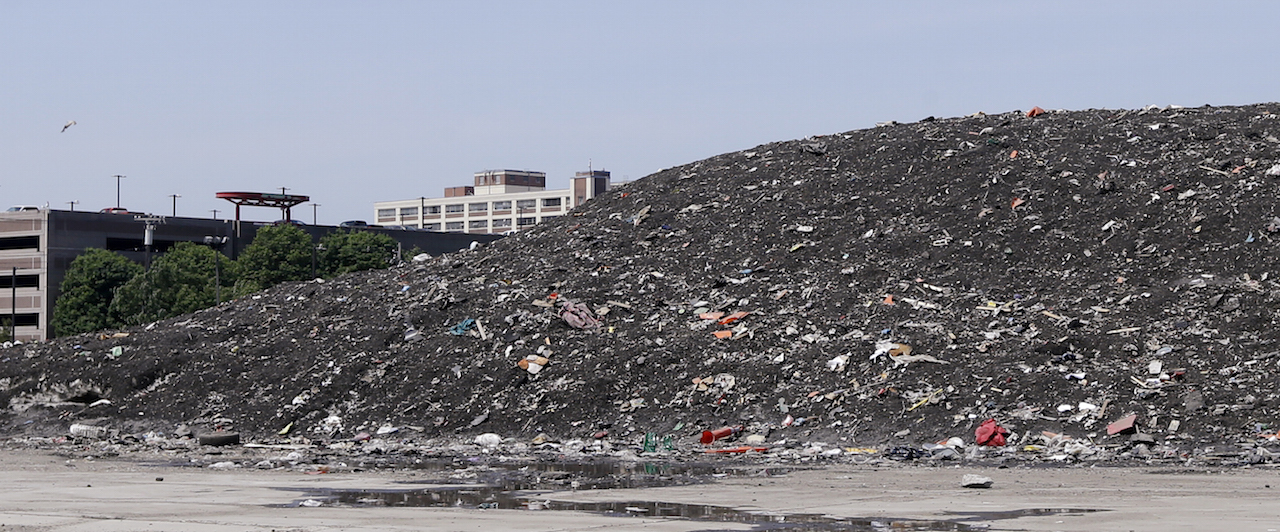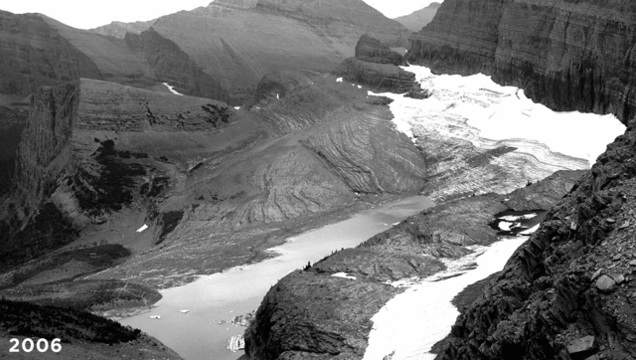Over the winter, the Eastern US was blanketed in blizzard after blizzard. As a stark reminder of Mother Nature’s bitchiness, two snow-plowed piles of that record snowfall lingered well into summer in two different cities. One of them is still frozen — a mud-caked sno-cone slowly oozing in the sun.
The giant snow piles which have managed to captivate the world’s imagination are in Buffalo, two cities which, contrary to the way they might feel most of the year, are far outside the Arctic Circle. While Boston’s pile eventually turned to sludge five months after its creation (it officially melted July 14), Buffalo’s pile just celebrated its eight-month birthday, even as temperatures reached 30 degrees Celsius. I turned to a glaciologist to help me understand why these frozen mounds ended up sticking around for so long, and if we could learn anything from a hunk of dirty snow.
A tale of two freezes
Not all snow piles are created equal. Although both of these mini-Matterhorns were created by plows collecting tons of snow from all over their cities, the piles themselves differed greatly — both in how and when they were stacked, and what’s inside the hills themselves (not just snow!).
The 2014-2015 winter was Boston’s snowiest on record. During February 2015 alone, about 64 inches fell on the city. Instead of dumping all of it into the Harbour (which used to be common practice), the snow was collected in a vacant lot in the city’s seaport. At one point, the city was passing heaps of snow through a machine called an Aero Snow Melter, which can process 350 tons of snow per hour. But then it kept snowing, and not even the Aero Snow Melter was able to keep up in a season that saw a total of 280 centimetres of accumulation.
A collection of photos taken of the Boston pile from a nearby office building
Boston’s pile reached a maximum of 23 metres — so big it was summited and skied by two Powder magazine writers (they said it smelled awful). And that is the other critical thing to know about Boston’s pile: Because one of the most major snowfalls occurred on a trash pickup day where cans were knocked over into the streets as plows went by, this pile was saturated with garbage.
In Buffalo, a “Snovember” lake effect blizzard dropped a stunning seven feet of snow on the city in a single storm. The city was immobilized when plows couldn’t clear the roads fast enough because they didn’t have anywhere to put the snow. Officials estimated that somewhere between 10,000 and 11,000 truckloads of snow were taken to this site near the city’s Central Terminal. Buffalo’s pile was estimated at one point to be five stories tall.

The Buffalo pile in November 2014 after the city got seven feet of snow, photo by Mike Groll/AP
Where Boston’s pile was laced with trash, Buffalo’s was more of the pure white stuff. As the season wore on, a layer of dirt accumulated on top of the pile, which eventually sprouted with vegetation in spring. That’s why Buffalo’s has that fine dark coating on it, kind of like an Oreo cookie crust. With a creamy center.
So beside the differences in materials and construction, the story is the same: Winter ends and we have two huge piles of snow in cities with roughly the same climate. The days grow longer, the weather warms, and yet these piles were both still there on the first day of summer. How could it be possible that these things would not melt right away?
That snow is so last year
For answers, I turned to Simon Cook, a physical geographer who researches glaciers, geomorphology, and geohazards at Manchester Metropolitan University. It turns out the snow itself has likely changed slightly — just enough to make it stick around longer.
As the snow crystals in the pile melt and refreeze, it compresses the snow crystals each time. “Compared to fresh snow, the old snow will be slightly denser, with smaller air spaces and larger crystals,” says Cook. “This will be harder to melt than fresh snow.” You can see this happening first-hand on a footpath where snow that’s been compacted by people walking on it takes a longer time to disappear. Or when you’re hit in the face with a snowball, says Cook. “It’s much better to be hit by a fresh snowball than one that has been made from old snow.”
On a glacier, this transition is called firnification. Fresh snow that sticks around for another season turns into a granular ice called firn — German for “last year’s snow.” As it’s compacted down over the next winter, it turns into actual glacial ice.
But there is another factor that might be keeping the piles extra cool — all that crap on top of the snow.

Boston’s pile was still large and in charge on May 28, 2015, photo by Elise Amendola/AP
Like the snow piles, glaciers are also coated with dust and debris. But glaciologists still don’t have a complete understanding of how a surface debris layer affects ice melt, says Cook. A thin layer of sediment — up to a couple of centimeters — will absorb solar radiation, heat up, and melt the ice quicker. A thicker debris layer will insulate it, but it’s tough to say if the dirt that’s collected on top of Buffalo’s pile is enough to make a difference. “That boundary thickness between insulation and enhanced melting seems to vary, and there are some poorly constrained variables such as sediment porosity,” says Cook. “So it depends on how thick all that crap is on top of your snow piles!”
It also depends on the biological makeup of that crap. In all likelihood there’s a ton of industrial soot coating the piles which is actually accelerating the melt. This is supposedly what caused Europe’s glaciers to retreat during the onset of the Industrial Revolution.
Building glaciers by hand
It should be pointed out that Boston and Buffalo are not alone in this club — Winnipeg had four large snow piles at this time last summer which almost made it to fall. So let’s say, hypothetically, against all odds, Buffalo’s pile survives the summer. Could it technically become an… urban glacier?
Even if the Buffalo pile is still there during the next snowfall — which climatologists have said it totally might be — it still would not qualify as a glacier, says Cook. “It would take a lot more snow and time to make them, plus they have to flow — a key defining characteristic of a glacier is that it has to deform under its own weight.”
But there’s still something in this idea of human-formed snowpack. One of the unfunniest ongoing jokes during this snowpocalyptic winter was an idea to box up all the snow in the Eastern US and ship it to the drought-plagued Western US, where some places saw nonexistent snowpack this past winter and a lot of actual glaciers have shrunk dramatically in the last few years. As a Californian, I died a little watching this giant pile of snow turn into a trash swamp.

A retreating glacier in Glacier National Park, via the USGS’s Repeat Photography Project
Surely if we can pile up enough snow in a vacant lot that it stays frozen until August, we could preserve our dwindling snowpack? More to the point, can’t we start manufacturing ice sheets, slowly regrowing our glaciers?
That’s not practical, says Cook, but there are some technological interventions where humans have been successful at protecting existing snowpack. There are scientists who have been developing reflective thermal blankets to insulate glaciers — essentially, a take on Buffalo’s forever-frozen grass-covered snow pile.
With climate change producing colder, wetter winters for some parts of the country, these towers of snow might become an even more frequent occurrence. But there’s another anti-snow technology that’s gaining ground. In addition to the snow-melting machines like the one used in Boston, geothermal heating systems are being installed underneath roadways and footpaths. So even in places where we might see enough accumulation to make snowcapped urban mountains, our cities will probably melt the snow themselves before it ever has the chance to reach such great heights.
Top photo by Gary Wiepert/AP
